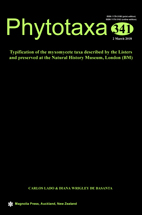Abstract
This paper describes a revision and typification of the slime mould or myxomycete taxa proposed by the Lister family, according to current nomenclatural and taxonomic criteria. It is based on the collections in the BM fungarium housed at the Natural History Museum, London, formerly called the British Museum (Natural History). Arthur Lister, and his daughter Gulielma Lister, conducted intense research between 1887–1945 on the taxonomy and description of new species of myxomycetes. Arthur Lister published one of the first monographs of the myxomycetes in the world “A monograph of the Mycetozoa” in 1894, from collections in BM. His daughter Gulielma Lister edited and revised a second (1911) and third (1925) edition of this keystone publication. The Listers maintained a strong relationship with the Museum, and so the BM holds most of the type specimens of the taxa described by them in the three editions of the monograph, and the huge number of the scientific papers they published on myxomycetes. In almost six decades of work, the Listers described 115 new taxa, and proposed more than 100 new name combinations, but some of them are of doubtful interpretation currently, and a clarification was needed of the nomenclatural position of the described species. A search was made of type material and documents housed in the Natural History Museum such as notebooks, collections of slides or personal annotated copies of the monographs. A large quantity of information was checked with the historically important notes and illustrations of the 50 personal notebooks, and 20 other books detailing collections studied or revised by these authors. Almost all of Lister’s nomenclatural novelties lacked type indication, although in some cases a herbarium identifier was given, often referring to multiple collections, and in other cases several collections were mentioned under the description of the new taxa, so a lectotypification was done. From the 115 new taxa described by the Listers, 2 holotypes have been determined, 2 neotypes and 86 lectotypes have been designated in this publication. In 2 taxa syntypes were found but the material was too poor to lectotypify. Ten taxa remain unresolved when the pertinent material was not located. The rest were illigitimate names or doubtful taxa. All the typification information has been standardized, the geographical information updated, and BM barcodes included to facilitate future work. A brief biography of Arthur and Gulielma Lister, some historical notes, and a revision of the organization and level of conservation of their collection at BM, are included. There are also appendices with doubtful and excluded taxa, all the new combinations proposed by these authors, a list of notebooks and a complete list of publications by the Listers.

